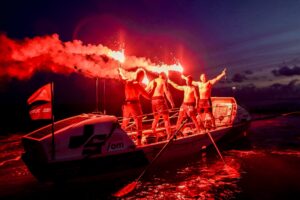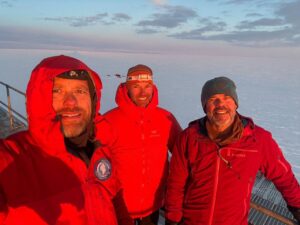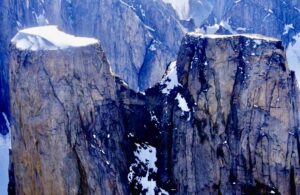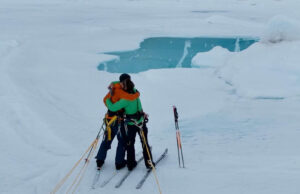Since our last ocean rowing roundup, few boats remain on the water. Three solo journeys continue, and one four-man team has aborted its Northwest Passage attempt.
Pacific Ocean
Tom Robinson: The young Australian is rowing across the Pacific Ocean from Peru to Australia. Robinson is not trying for any kind of speed record but is simply doing it for the experience.
He has stopped several times. His first layover was in the Cook Islands, where he waited out the cyclone season in Penrhyn. Then he rowed to American Samoa and stayed there for a month. This was the lowest point of the experience so far. The rowing had been draining, he was ill with a recurring flu, and his boat needed repairs. He was ready to quit. After a few weeks on the island and some kindness from strangers, he felt more positive.

Tom Robinson’s route so far.
He began his third leg on July 2. Two months later, on September 11, he landed in Vanuatu. He actually arrived at the archipelago 19 days earlier but couldn’t make it ashore.
Robinson initially had no intention of stopping, but as winds picked up, he changed his mind. He tried to anchor near Gaua Island, but reefs made it inaccessible. Then he saw two people jump in a canoe and start paddling toward him to guide him through a tiny crack in the reef.
As he made his way along the coastlines, villagers canoed out to him and offered food and conversation. Then a German yacht appeared and agreed to tow him to Luganville, where he would be able to land properly. He has not said when he plans to continue his journey to Australia.
Atlantic Ocean
Jari Saario: On January 23, the Finnish rower started his bid to complete a double crossing of the Atlantic. He planned to row from the Canary Islands to Miami, then travel to New York and recross the Atlantic to London. Unfortunately, very little went according to plan.

Jari Saario is rowing from Canada to Finland. Photo: Jari Saario/Facebook
His first crossing ended on March 28 in Antigua. Electrical issues affected both his GPS and communication devices and forced him to shorten that leg of the journey. He went back to Finland and rethought his route. In the end, he decided to cross from Newfoundland, Canada to Finland.
Five days after launching on June 22, two out of three rudder controls had broken. Saario could steer with ropes but not row at the same time. Strong winds started pushing him back toward his starting point. Luckily, with help from his land team, he managed a fix. July 26 marked his 100th day at sea this year.

Jari Saario makes it to Loch Ness. Photo: Jari Saario/Facebook
Seventy-five days later, he arrived in Scotland. After spending some time repairing his boat, he will make his way across the Caledonian Canal Route to the North Sea. His original plan was to row the English Channel or north of Scotland, but strong winds would have made progress difficult. So in the end, he picked a more sheltered way.
Northwest Passage
NWP Expedition: This four-man team was trying to row the Northwest Passage in a single season from Baffin Island, Canada to Point Burrow, Alaska. Experienced ocean rower Leven Brown is leading the team on the 3,700km journey.

Levin Brown, the skipper on the NWP Expedition. Photo: NWP Expedition/Facebook
They started their row on August 17 and made good progress at first. But in Cresswell Bay, just north of Bellot Strait, difficult conditions prompted them to use their electric motor, depriving their expedition of its self-supported status. Then their daggerboard split in half on a sandbank, but they had a spare.
After 13 days, they reached Bellot Strait. Here, they waited for calm weather before relaunching on September 1. They made good progress past Victoria Island, the location of Cambridge Bay.
Again, they waited for calm weather, but with the arrival of arctic fall, such days were fewer and shorter. The high winds and large waves deterred them enough that on September 14, they decided to abort the expedition with 1,100km to go. They are now making their way back toward Cambridge Bay, where they will store the boat over winter. Brown says they will return to finish the undone portion next summer.

NWP Expedition. Photo: NWP Expedition/Facebook
Solo arctic rower
Matty Clarke: Clarke is rowing the Northwest Passage alone from west to east — the opposite direction from the Brits above and the four kayakers, who are continuing their paddle despite the wintry conditions. Clarke started the journey with companion Adam Riley, with a plan to row the Passage in one season. After two weeks, Riley injured his shoulder and had to pull out, but Clarke has continued alone.
Clarke is using a kayak that you row rather than paddle. His former partner is now helping with logistics.
On August 28, he reached the Inuit town of Cambridge Bay, a little less than halfway. Here, he made repairs to his boat and waited out rough weather.
“The next 500 miles will be the most difficult I’ve ever done,” he said. “The weather window gets shorter and shorter, and I’ve three big crossings left.”
His daggerboard has broken twice, and he fixed it twice. Then on September 8, the hull of his boat cracked in big waves as his boat repeatedly went vertical and slapped down hard on the water. It now leaks. “This is different from a hole from ice or a rock,” he explains. He is trying to fix the structural issue with the materials at hand but is unsure if he will be able to continue in the rough autumn seas.






